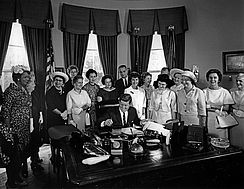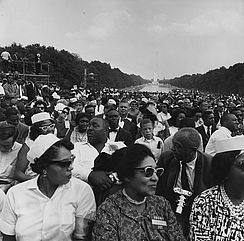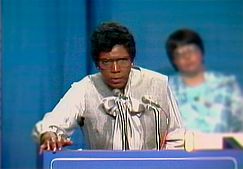Body & Health
Sporting Bodies
The answer is no: Sex does not sell sports. The real question is: when will women’s sports get the same kind of media coverage that men’s sports get?
Excerpt from “Media Coverage and Female Athletes,” a film by the Tucker Center for Research on Girls & Women in Sport at the University of Minnesota, and tptMN. (Running time 16:13) Used with permission. This clip features the WNBA's Minnesota Lynx — Champions in 2011 and 2013.
To see another revolution concerning women’s bodies in action, just check out the playing fields of your local high school or town recreational league: Girls will be running around the track or swimming laps in the pool, women will be playing soccer or softball. The halls of high schools and community centers will be lined with team photos of girls’ championship teams alongside boys’. In one generation we have gone from young girls hoping there is a team they can play on to young girls hoping they make the team. Girls and women now take access to sports and athletics for granted, seeing it as a right, not a privilege, a huge difference from their mothers and grandmothers. When assessing changes in women’s lives over the past half century, access to sports surely ranks as one of the most far-reaching transformations.
But look again at this picture. Even though girls and women have far more chances to compete than they used to, why do they still get only about 43 percent of athletic opportunities even though they make up a majority of students? Why do women’s professional sports (with the exception of tennis) struggle for acceptance and respect? The celebration of how much has changed must always be balanced by the fact that there is still a long, long way to go before we truly reach gender equity, in sports or any other aspect of American society.
A key player (it’s hard to avoid sports metaphors when talking about this topic) in the revolution in women’s sports is a piece of federal legislation passed in 1972: Title IX of the Education Amendments. The words “Title IX” have become practically synonymous with women’s sports, but the original law said nothing about athletics. Instead it was designed to address general patterns of discrimination and inequality in education, such as quotas that limited women’s enrollment in professional schools or the practice of automatically expelling students if they became pregnant. Pretty soon it dawned on many people that the area in education where disparities in treatment for women were the most extreme was the field of sports.
How did the Yale women’s rowing team protest the lack of equal facilities — a violation of Title IX?
Excerpt from “A Hero For Daisy,” a film by Mary Mazzio. (Running time 3:12) Used with permission. The complete film is available from 50 Eggs, Inc.
As bureaucrats in Washington tried to figure out how to implement the law (a process that took most of the 1970s), those with a vested interest in the sports status quo (especially football coaches) made it sound like the world would end if women shared the sports dollar on a par with men. But sports activists had the law on their side, and they put it to good use. For example, in 1976 the Yale women’s crew team staged a newsworthy protest — the entire team walked into the office of the women’s athletic director and stripped naked to reveal “Title IX” written on their bodies — to force change on their campus from foot-dragging administrators.
Indeed, the 1970s proved a breakthrough decade for women in sports. In one frequently cited figure, high school sports participation rates for girls rose from one in 27 in 1971 to one in three by 1979. Not all that progress can be attributed specifically to Title IX, but the amendment definitely acted as an important spur. In addition to expanded opportunities for team sports on the high school and collegiate level, individual women’s sports also enjoyed broader public support, spurred by the tennis and running booms of the 1970s, followed by the popularity of aerobics in the 1980s. Being female now increasingly included being physically fit and active.
After leveling off in the 1980s, participation in women’s sports experienced another spurt forward in the 1990s, but still faced constraints in a climate of competition for scarce resources. The focus of debate over Title IX enforcement largely shifted from how to improve and expand opportunities for women athletes to the fear that male athletes, especially in less popular sports like wrestling, would have cuts in funding for their programs. Unfortunately, athletics is often presented as a zero-sum game: if women win, then men lose. In an increasingly polarized climate, it is easier to blame women than to look at the underlying priorities and problems with athletic budgets in general.
Title IX confirms the difficulties — and the rewards — of putting abstract principles like equal opportunity and gender equity into concrete practice: If you give jock straps to the men, then you should provide sports bras for the women. And yet groups such as the National Organization for Women were not very interested in sports. Compared to other “body” issues like rape, reproductive rights, sexual harassment, and demeaning portrayals in the media, the issue of women in sports was seen as somewhat frivolous. In a classic mind/body split, feminists promoted a theoretical and political agenda for women at the expense of women’s real body experiences. Tennis superstar Billie Jean King dismisses this mindset as “thinking from the neck up.”
And yet a feminist perspective is very relevant to women’s sports. Ask most parents whether their daughter should be able to play ice hockey or wrestle in high school, or have access to the town’s playing fields for her soccer practices, and all of a sudden many of the tenets of modern feminism come flooding out: equal opportunity, fairness and equity, taking girls and women seriously. As a reporter covering town politics once noted, “There is no more radical feminist than the father of an elite female athlete.” In other words, his daughter deserves all the opportunities and resources that his son might get, even if it means fighting the school board, the local newspaper, the booster club, and whoever else stands in the way of her developing her full athletic potential.
There are definite downsides to women’s increased athletic participation. Homophobia is endemic in the sports world: One of the most potent ways to discourage women from participating is to link their athletic prowess with sexual deviance by calling them “dykes.” Many female athletes report sexual abuse by male coaches, a power imbalance which is especially lethal because of the influence that coaches wield over individual athletes. The desire for control and perfection that drives athletic excellence can also lead to anorexia and bulimia as athletes succumb to societal and coaching pressures to lose weight. And that competitiveness, especially for the athletic scholarships that Title IX opened to women as well as men, can put extreme stress on still-growing bodies as the sports season becomes year-round.
An especially galling problem is the lack of media coverage devoted to women’s sports. Despite accounting for more than 40 percent of all athletes, women receive only 4 percent of the media coverage. And the coverage they do receive (think of the attention Brandi Chastain’s black sports bra received after the U.S. won the Women’s World Cup in soccer in 1999) is much more likely to accentuate their bodies and their sexuality than comparable coverage for men. Women athletes want respect, and instead they get treated like cheesecake. But sex doesn’t sell women’s sports; it’s the individual women athletes who do. And research shows tremendous interest in women’s sports and women athletes — you just would never know it by watching ESPN, reading Sports Illustrated, or perusing the sports pages of your local newspaper.
Until sports opportunities were made available to women, it was taken as a given that men and women could not compete together in sports because men were faster and stronger than women. More than forty years of Title IX have shown what the female body is capable of — pretty much anything that the male body is. Like sexuality, sports ability can be thought of as a spectrum, as Mary Jo Kane pointed out: “there exists today a sports continuum in which many women routinely outperform many men and, in some cases, women outperform most — if not all — men in a variety of sports and physical skills/activities.” Billie Jean King showed that decisively in the historic tennis “Battle of the Sexes,” when she defeated challenger Bobby Riggs in 1973. It is not the case that every elite male can outperform every elite female or that even marginal males can outperform the best female. And yet because men’s and women’s sports are usually kept rigidly separate, we rarely have the chance to actually see women outperforming men in sports venues, mixed doubles in tennis being an interesting exception. When women compete and hold their own against men, it threatens and undermines the binary opposition that insists that the sexes are fundamentally different, and by extension, that women are the second sex. The rest of the world has gone coed — why not sports?

How to Navigate our Interactive Timeline
You will find unique content in each chapter’s timeline.
Place the cursor over the timeline to scroll up and down within the timeline itself. If you place the cursor anywhere else on the page, you can scroll up and down in the whole page – but the timeline won’t scroll.
To see what’s in the timeline beyond the top or bottom of the window, use the white “dragger” located on the right edge of the timeline. (It looks like a small white disk with an up-arrow and a down-arrow attached to it.) If you click on the dragger, you can move the whole timeline up or down, so you can see more of it. If the dragger won’t move any further, then you’ve reached one end of the timeline.
Click on one of the timeline entries and it will display a short description of the subject. It may also include an image, a video, or a link to more information within our website or on another website.
Our timelines are also available in our Resource Library in non-interactive format.
Timeline Legend
Yellow bars mark entries that appear in every chapter
This icon indicates a book
This icon indicates a film
1971 The Click! Moment
The idea of the “Click! moment” was coined by Jane O’Reilly. “The women in the group looked at her, looked at each other, and ... click! A moment of truth. The shock of recognition. Instant sisterhood... Those clicks are coming faster and faster. They were nearly audible last summer, which was a very angry summer for American women. Not redneck-angry from screaming because we are so frustrated and unfulfilled-angry, but clicking-things-into-place-angry, because we have suddenly and shockingly perceived the basic disorder in what has been believed to be the natural order of things.” Article, “The Housewife's Moment of Truth,” published in the first issue of Ms. Magazine and in New York Magazine. Republished in The Girl I Left Behind, by Jane O'Reilly (Macmillan, 1980). Jane O'Reilly papers, Schlesinger Library.




























































